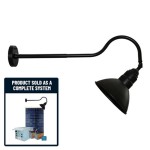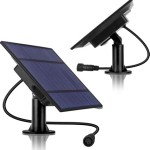How Do Outdoor Solar Lights Work?
Outdoor solar lights have become increasingly popular as a sustainable and energy-efficient lighting solution for gardens, pathways, decks, and more. Their ability to harness the power of the sun and provide illumination without relying on the electrical grid makes them a practical and environmentally friendly choice. However, understanding how these lights operate can seem complex. This article will break down the inner workings of outdoor solar lights, explaining their key components and the processes involved in converting sunlight into usable energy.
Solar Panel: Capturing Sunlight
The heart of any solar light is the solar panel, a crucial component responsible for converting sunlight into electricity. Solar panels are made up of photovoltaic cells, which are semiconductor materials, typically silicon, designed to absorb sunlight. When sunlight strikes the cells, it dislodges electrons, creating a flow of electricity. The amount of electricity generated depends on the intensity of sunlight and the size of the solar panel. Larger panels can capture more sunlight and produce more electricity.
Battery: Storing Energy
The electricity generated from the solar panel needs to be stored for use when darkness falls. This is where the battery comes into play. Most outdoor solar lights utilize rechargeable batteries, commonly lithium-ion batteries, known for their high energy density and long lifespan. The battery acts as a reservoir, storing the electricity generated by the solar panel during daylight hours. As the sun sets and the light needs activation, the stored energy is released to power the LED lights.
LED Lights: Efficient Illumination
The final component of the solar light system is the LED light. Light-emitting diodes (LEDs) have revolutionized the lighting industry due to their high energy efficiency and long lifespan. Compared to traditional incandescent bulbs, LEDs consume significantly less energy while emitting bright and focused light. This energy efficiency is crucial for solar-powered lights, ensuring that the stored energy in the battery can last for extended periods.
The Conversion Process: From Sunlight to Light
The process of converting sunlight into usable light involves several steps. Firstly, the solar panel absorbs sunlight, generating a direct current (DC) electric flow. This DC electricity is then passed through the battery, where it is stored. When darkness falls, the energy stored in the battery is converted back into DC electricity. This DC current is then passed through a circuit that regulates and converts it into the appropriate voltage to power the LEDs. The LEDs then emit light, illuminating the surrounding area.
Factors Affecting Performance
The performance of outdoor solar lights can be influenced by various factors. Sunlight intensity plays a crucial role. Stronger sunlight leads to greater electricity generation, allowing for longer illumination times. The size and efficiency of the solar panel also impact the amount of energy stored in the battery. The battery capacity, measured in milliampere-hours (mAh), determines how long the lights can operate before needing recharging. Additionally, environmental factors like temperature and weather conditions can affect the performance of solar lights.
Choosing the Right Solar Lights
When selecting outdoor solar lights, several factors should be considered:
- Brightness: Measured in lumens, determines how bright the light will be.
- Light Color: Options include warm white (yellowish hue), cool white (bluish hue), and daylight (closer to natural sunlight).
- Battery Capacity: Affects how long the lights can operate before requiring recharging.
- Solar Panel Size: Large panels can capture more sunlight, ensuring sufficient charging.
- IP Rating: Indicates the light's resistance to water and dust, ensuring durability in outdoor environments.
By understanding the basics of how outdoor solar lights work, individuals can make informed decisions when choosing the best lighting solution for their needs. With their energy efficiency, environmental friendliness, and ease of installation, solar lights continue to offer a practical and aesthetically pleasing approach to outdoor illumination.

How Do Outdoor Solar Street Lights Work Exc
How Solar Yard Lights Work Howstuffworks

Installing Solar Garden Lights Learn About Powered

Do Solar Lights Work In The Shade Or Need Direct Sunlight Conserve Energy Future

How Do Solar Lights Work

How Do Solar Lights Work Les Jardins Official Site

How Solar Yard Lights Work Powered

Solar Lights Distance And Spacing Tips Living By Homeserve

Solar Light

Solar Lights Do They Work In The Shade Renewables Numbers
Related Posts







